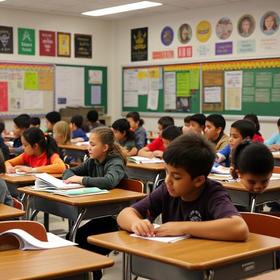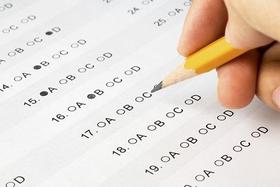Serving 298 students in grades Kindergarten-12, Falcon Heights ranks in the bottom 50% of all schools in Oregon for overall test scores (math proficiency is bottom 50%, and reading proficiency is bottom 50%).
The percentage of students achieving proficiency in math is 6-9% (which is lower than the Oregon state average of 31%). The percentage of students achieving proficiency in reading/language arts is 11-19% (which is lower than the Oregon state average of 44%).
The student-teacher ratio of 25:1 is higher than the Oregon state level of 17:1.
Minority enrollment is 32% of the student body (majority Hispanic), which is lower than the Oregon state average of 42% (majority Hispanic).
Quick Facts (2025-26)
- School Type: Alternative school
- Grades: Kindergarten-12
- Enrollment: 298 students
- Student-Teacher Ratio: 25:1
- Minority Enrollment: 32%
- Graduation Rate: 45-49% (Btm 50% in OR)
- Overall Testing Rank: Bottom 50%
- Math Proficiency: 6-9% (Btm 50%)
- Reading Proficiency: 11-19% (Btm 50%)
- Science Proficiency: ≤10% (Btm 50%)
- Source: National Center for Education Statistics (NCES), OR Dept. of Education
Top Rankings
Falcon Heights ranks among the top 20% of public schools in Oregon for:
Category
Attribute
Percent Eligible For Free Lunch
School Overview
Falcon Heights's student population of 298 students has grown by 254% over five school years.
The teacher population of 12 teachers has grown by 140% over five school years.
School Type
Grades Offered
Grades Kindergarten-12
(Supplemental Virtual)
(Supplemental Virtual)
Total Students
298 students
Gender %
Total Classroom Teachers
12 teachers
School Calendar
School Rankings
Falcon Heights ranks within the bottom 50% of all 1,174 schools in Oregon (based off of combined math and reading proficiency testing data).
The diversity score of Falcon Heights is 0.50, which is less than the diversity score at state average of 0.60. The school's diversity has stayed relatively flat over five school years.
Overall Testing Rank
#1157 out of 1174 schools
(Bottom 50%)
(Bottom 50%)
Math Test Scores (% Proficient)
6-9%
31%
Reading/Language Arts Test Scores (% Proficient)
11-19%
44%
Science Test Scores (% Proficient)
≤10%
30%
Student-Teacher Ratio
25:1
17:1
American Indian
7%
1%
Asian
1%
4%
Hispanic
18%
26%
Black
n/a
3%
White
68%
58%
Hawaiian
n/a
1%
Two or more races
6%
7%
All Ethnic Groups
Graduation Rate
45-49%
81%
Eligible for Free Lunch
80%
51%
Eligible for Reduced Lunch (21-22)
14%
8%
School Statewide Testing
School District Name
Source: National Center for Education Statistics (NCES), OR Dept. of Education
Profile last updated: 02/09/2025
Frequently Asked Questions
What is Falcon Heights's ranking?
Falcon Heights is ranked #1157 out of 1,174 schools, which ranks it among the bottom 50% of public schools in Oregon.
What percent of students have achieved state testing proficiency in math and reading?
6-9% of students have achieved math proficiency (compared to the 31% OR state average), while 11-19% of students have achieved reading proficiency (compared to the 44% OR state average).
What is the graduation rate of Falcon Heights?
The graduation rate of Falcon Heights is 45-49%, which is lower than the Oregon state average of 81%.
How many students attend Falcon Heights?
298 students attend Falcon Heights.
What is the racial composition of the student body?
68% of Falcon Heights students are White, 18% of students are Hispanic, 7% of students are American Indian, 6% of students are Two or more races, and 1% of students are Asian.
What is the student-teacher ratio of Falcon Heights?
Falcon Heights has a student ration of 25:1, which is higher than the Oregon state average of 17:1.
What grades does Falcon Heights offer ?
Falcon Heights offers enrollment in grades Kindergarten-12 (Supplemental Virtual).
What school district is Falcon Heights part of?
Falcon Heights is part of Klamath County School District.
School Reviews
Review Falcon Heights. Reviews should be a few sentences in length. Please include any comments on:
- Quality of academic programs, teachers, and facilities
- Availability of music, art, sports and other extracurricular activities
Recent Articles

How Public Schools Support Students on Free / Reduced-Lunch Programs
Explore how U.S. public schools support students eligible for free or reduced-price lunch through nutrition, academic, and wraparound services in 2025.

Hidden Costs of Public Schools: Fees, Supplies & Extras
Explore the hidden costs in public schools鈥攆ees, supplies, extracurriculars鈥攁nd how parents can plan for them in 2025.

Public School Funding 2025: What Families Should Know
Essential insights on public school funding in 2025鈥攈ow it works, what鈥檚 changing, and what families should know to stay ahead.





